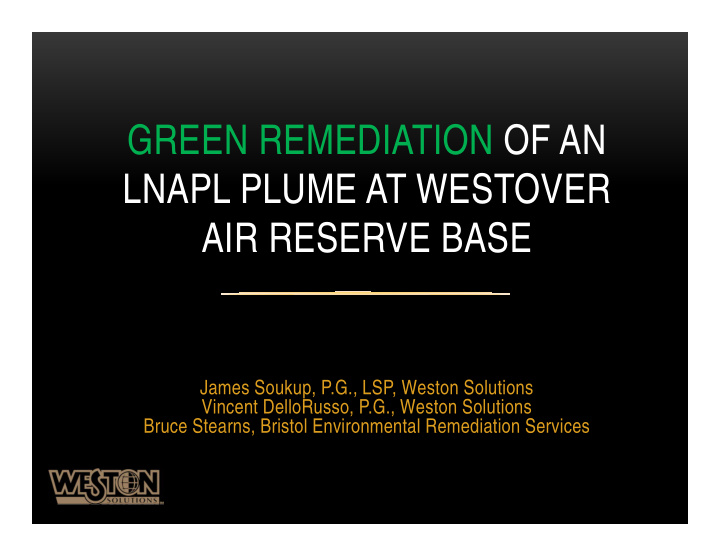



GREEN REMEDIATION OF AN LNAPL PLUME AT WESTOVER AIR RESERVE BASE James Soukup, P.G., LSP, Weston Solutions Vincent DelloRusso, P.G., Weston Solutions Bruce Stearns, Bristol Environmental Remediation Services
TEAM MEMBERS • Vinnie DelloRusso, Weston Solutions • Bruce Stearns, Bristol Environmental Remediation Services • Paul Kwiatkowski, WARB Environmental Wing • Jack Moriarty, WARB Environmental Wing • Matt Ellender, Army Corps of Engineers • Steve Deatherage, DLA Logistics Support • Vergel Casunuran, Booz Allen Hamilton • Cindy Pawloski, MassDEP
WESTOVER ARB • Chicopee, Massachusetts • Largest Air Force Reserve Base in the country at 2,500 acres Home to 439 th Airlift Wing flying • the C-5 Galaxy 337 th Airlift Squadron is the • Wing’s flying unit • Their mission: Deliver oversized cargo around the world
Residential Residential Area Area Industrial Area
THE RELEASE • Refueling ramp • 6,240-ft JP8 supply pipeline loop • 14”-12” dual-walled pipe • 8 valve pits at 250-ft intervals • In October 2010, 150 gallons of JP8 found in valve pit E-7 • 2-hour reportable condition • Second valve pit E-2 found to contain JP8
IMMEDIATE RESPONSE ACTIONS • Imminent Hazard identified • Pipeline shut down and drained • 5,800 gallons of JP8 pumped from the two valve pits • Estimated that >20,000 gallons had been released Sheen noted near abandoned storm drain • across refueling ramp • Outfall was sealed to prevent release
COMPREHENSIVE RESPONSE ACTIONS • Phase I and Tier Classification (Tier II) • No Critical Exposure Pathways • Phase II: Over 30 Monitoring wells installed to map LNAPL extent • LNAPL removed from wells via vac truck at periodic intervals • Dissolved groundwater concentrations meet Method 1 • Soil expected to pass Method 3 Risk Characterization
ECHO 2 PLUME
ECHO 7 PLUME
COMPREHENSIVE RESPONSE ACTIONS • Phase III: Evaluation of Remedial Alternatives for LNAPL recovery • Alternatives limited by mission- critical nature of fueling ramp • Continue periodic vacuum extraction of LNAPL using a vac truck
COMPREHENSIVE RESPONSE ACTIONS • Phase IV and V: Limited effectiveness of vacuum extraction • Restricted access to refueling ramp limits frequency of events • LNAPL levels shown to vary significantly with water elevation • Removing more groundwater than LNAPL
REVISED APPROACH: GREEN REMEDIATION • Reduction in aircraft allowed more sustained access to refueling ramp • Goals: • Reduce per/gallon cost of LNAPL removal • Improve LNAPL recovery rate to achieve Permanent Solution sooner • Employ Green Remediation concepts
REVISED APPROACH: GREEN REMEDIATION • LNAPL skimmer pumps determined to be most cost-effective alternative • Design Challenges: • Isolated location – self contained • Limited access – reliable • Quick setup/takedown – mobile • Height restrictions – low profile
REVISED APPROACH: GREEN REMEDIATION • Selected Xitech LNAPL skimmer pumps • Solar powered system • Fully automated • LNAPL storage/recycling • Easy setup and takedown
GREENING THE REMEDY • Materials: Designed for reuse/rented • Power and Fuel: Pneumatic pumps/Solar powered controller • Project Planning and Management: Teleconferencing, local vendors, electronic submittals • Residual Solid/Liquid Waste: Recycle recovered LNAPL • Vehicles and Equipment: Carpooling, local vendors, remote system operation and monitoring
LNAPL RECOVERY SYSTEM
LNAPL RECOVERY SYSTEM
RESULTS • Removed 1,000 gal of LNAPL in 4 months • Reduced cost/gallon from $370 to $160 • Permanent Solution estimated in 2-4 years
SYSTEM OPTIMIZATION • Pumping frequency/duration adjustments • Heat tracing of moisture dropout for winter operation • Additional battery storage capacity • Moisture filters for compressor • 4” versus 2” diameter wells
CONCLUSIONS • Green Remediation does not have to be more expensive! • Many cost-saving measures are green • Review the Best Management Practices in the guidance • Tweak your remedial approach
FUTURE WORK • Monitor groundwater elevations and LNAPL thickness • Remobilize recovery system when water levels and ramp access permit • Estimate another 2,000 to 3,000 gallons of recoverable LNAPL remain • Issue Permanent Solution Statement once no longer feasible to recover remaining LNAPL
QI;ommontveaUb of Jf!massacbusetts Modified Phase IV Remedy Implementation Plan, Final Inspection Report, and �!lean tGreeqer • •" Environmentbl Protection Milssachusetts Department of Assisl.!Vlt Commissioner - Bureou of W•ste Site Clconup September 26, 2017 Phase IV Completion Statement (RTN: 1-17977). Hydrant Fuel System Release Site - Areas E-2 and E-7 Project DEPARTMFNT OF ENVIRONMENTAL PROTECTION Westover Air Reserve Base is recognized for the greenhouse gases, water use, materials consumption, and ecosystem and water resources impacts. with the MCP by eliminating or reducing the total energy use, air pollutant emissions, net environmental fpotprint of assessment and remedial response actions conducted in accordance and implementing such "Greener Cleanup" principles and practices that reduce the overall For demonstrating exemplary professional performance in identifzing. selecting. prioritizing Westover Air Reserve Base is given to Greener Cleanup Leadership Recognition Award ups
Recommend
More recommend